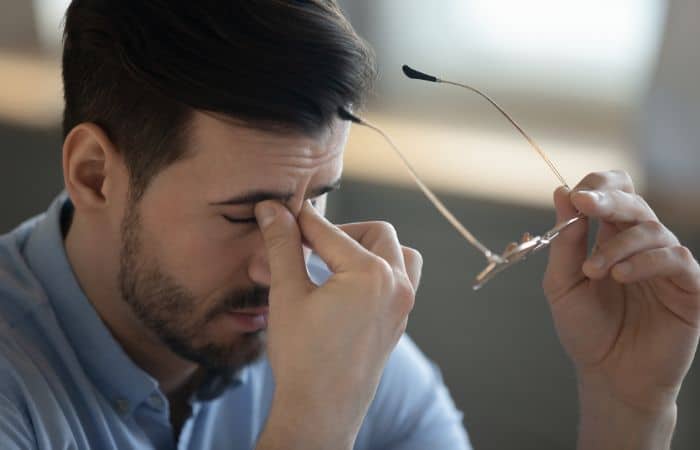If you’ve just gotten a new pair of prescription glasses, you’re probably excited to finally see well. Finally, you think, now I can watch tv without squinting or see my child clearly on the field…except that you’re not experiencing perfect vision quite yet, and may actually be having some discomfort.
Don’t worry, this is normal! It may take a little bit of time for your brain and eyes to adjust to your new glasses. Here’s what you can expect in those first few days and weeks.
When Will My Eyes Adjust to My New Glasses?

On average, it should take about 3-4 days for your eyes to adjust to new glasses. This assumes that you don’t have a high prescription, which normally takes a bit longer to get used to. If you’ve only made a small change to your current glasses prescription, it may not take as long for your eyes to adjust.
For some people, it can take up to a week or so to get used to a new pair of glasses. This is especially true if you’ve made a significant change to your prescription or are wearing glasses for the first time.
If it’s been more than a couple of weeks and you’re still not seeing well or are experiencing discomfort, make an appointment with your eye doctor.
New Glasses Symptoms
So what can you expect during this adjustment period? It’s not exactly the same for everyone, but some common symptoms include:
Eye Strain
Stressed or strained eyes is a common issue for those adjusting to new glasses. This is because your eyes aren’t used to focusing with the new lenses you just got. If you previously wore a different set of glasses with your old prescription, your eyes may have gotten used to that particular lens shape and distance from your eyes.
If you’re experiencing a lot of eye strain, try closing your eyes for a few minutes every hour or so. This will help give your eyes a break. You can also try looking at distant objects every so often to give your eyes a chance to focus on something else.
The good news is that this should only last a couple of days as your eyes get used to the new prescription.
Visual Distortion

Changing from a single-vision lens to bifocal or progressive lenses can be a big adjustment. You may notice that objects appear smaller or larger than they actually are, or that lines appear wavy.
Aside from adjusting to the different corrections between the top and bottom of your new lenses, you may also experience changes in your peripheral vision. You might notice distorted vision especially when climbing stairs, driving, or walking around.
If you’re having trouble with this, try moving your head instead of your eyes to look at something. For example, when going up stairs, fix your gaze on a point a distance away and move your whole head to keep it in your sight.
This will help train your brain to use the right muscles to focus your vision.
Blurry Vision or The Fishbowl Effect
Counterintuitively, your new prescription might make you feel like you have blurry vision instead of crystal clear vision. Or, it might give you the fishbowl effect – when your periphery looks bent like you’re peering through a fishbowl.
The latter can happen if you have a strong minus prescription without a thinner, high-index lens. However, it’s still possible to experience the fishbowl effect even without a high Rx.
Remember also that your vision changes throughout the day depending on how tired your eyes are, adjusting to different light conditions, etc. This means that you may feel like your vision is clearer at some times than others.
Dizziness and Nausea

It’s not uncommon to feel dizzy or nauseous when you first start wearing glasses. This is usually due to issues with your depth perception, which can feel like motion sickness.
When you put on new prescription glasses for the first time, your brain may need a bit to learn how to interpret the new visuals it’s receiving, making you feel dizzy or disoriented.
If this is the case, try to take things slow for a few days. Don’t make any sudden movements and avoid strenuous activities. You can also try closing your eyes for a few minutes every hour to give your brain a break.
If you’re still feeling dizzy after a week or so, give your eye doctor a call.
Headaches

If you experience headaches soon after getting your new glasses, it’s likely because you’re not used to wearing them yet.
It can take some time for both your eyes and your brain to adjust to a new prescription. Your eye muscles are used to focusing a certain way for you to see – which is altered by looking through new lenses.
Besides that, your brain also needs to compensate for the different way it’s receiving visuals. All of this can cause headaches, which should go away after a day or two.
If you’re still getting headaches after several days, give your doctor a call. There could be an underlying issue causing the headaches.
When Should I Contact My Eye Doctor?
If you’re still experiencing any of the above symptoms after two weeks of wearing your new glasses, it’s time to give your eye doctor a call. Ongoing symptoms can be a sign that you don’t have the appropriate prescription, or that your new glasses aren’t fitting you properly.
Your doctor will be able to help you out and make sure that you’re seeing clearly and comfortably.
Tips for Getting Used to Wearing Glasses
Gradually Increase How Long You Wear New Prescription Glasses
Just like adding a new routine or habit to your life, the best way to get used to wearing glasses is to start small and gradually increase the time you spend wearing them.
If you’ve never worn glasses before, try wearing them for an hour or two the first day. The next day, try adding an additional hour. And so on, until you’re comfortable wearing them all day long.
The key is to wear them regularly when needed so that your eyes and brain can get in the habit of seeing through your new lenses. Also, don’t go back to wearing your old glasses, as you want to train your eyes and brain to adjust to your new lenses.
Exercise Your Eyes
If eye strain is an issue for you, particularly if you work at a computer all day, try looking at something far away for 20 seconds every 20 minutes (ideally – but at least once an hour).
This will help reduce strain on your eyes and give them a break from looking at close objects for extended periods of time.
If you’re wearing bifocals or progressives for the first time, you can also try looking down through your lens and try focusing on objects at various distances. This will help you get used to the different focal points and make the transition smoother.
Keep Your Lenses Clean
Besides making it difficult to see, dirty lenses can also irritate your eyes.
Make sure to keep your glasses clean by washing them with soap and water regularly. You can also use a little lens solution and a microfiber cloth to gently clean your lenses.
Wipe down the frame of your glasses as well so that there’s no dirt, dust, or oil build-up.
Final Thoughts
Getting used to new glasses can take some time, but in most cases should resolve itself in a few days. Remember that it takes both your eyes and your brain a little bit of time to adjust to seeing with a new prescription, and that you’ll more than likely have clearer vision without any problems.
If you’re still having difficulties after two weeks, give your doctor a call. They’ll be able to help ensure that your lenses were made properly and that nothing else is amiss with either your health or glasses.